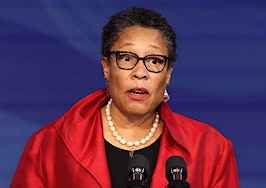The moment has arrived — the moment to take charge. This summer, at Inman Connect Las Vegas, July 30-Aug 1, 2024, experience the complete reinvention of the most important event in real estate. Join your peers and the industry’s best as we shape the future — together. Learn more.
Inflation increased 3.2 percent annually in February, while jumping 0.4 percent from the previous month, according to data released Tuesday by the U.S. Bureau of Labor Statistics.
Combined, shelter and gasoline prices contributed more than 60 percent to February’s increase, according to the Bureau’s Consumer Price Index (CPI). Core inflation, which excludes volatile food and energy prices, fell to 3.8 percent annually, down from 3.9 percent in January.
The index for housing eased from a 0.6 monthly increase in January to a 0.4 monthly increase in February — but was still up 5.7 percent for the year.
February’s inflation numbers were stronger than January’s, when inflation was up 3.1 percent annually and 0.3 monthly. While the 3.2 percent annual growth in the CPI last month was well below its peak of 9.1 percent tallied in June 2022, it’s still above the Federal Reserve’s 2 percent target.
The Federal Reserve’s preferred inflation gauge, the personal consumption expenditures (PCE) price index, dropped to 2.4 percent in January, down from 2.6 percent in December. The PCE index for February will be released on March 29.
Some economists said the latest CPI data calls into question previous optimistic predictions for the U.S. economy.
“Today’s inflation data puts a question mark on whether the economic soft-landing, that is currently widely expected, will actually be achieved,” Realtor.com Chief Economist Danielle Hale said.
The updated inflation numbers come eight days before the Fed’s next meeting, which is widely expected to yield no change in interest rates. The lack of significant deceleration in inflation supports predictions that the Fed will not move to reduce interest rates until the latter half of 2024.
Federal Reserve Chair Jerome Powell reiterated during his semiannual monetary policy testimony last week that the body won’t issue any cuts to benchmark rates until it’s abundantly clear that inflation is under control.
“The Federal Reserve wants to see more evidence that inflation is slowing before cutting rates, which may simply mean more months of slow deceleration,” First American Economist Ksenia Potapov said in a statement. “The Fed is unlikely to cut rates before the latter part of this year, and February’s CPI numbers only solidify that.”
Editor’s note: This story has been updated to correct that the personal consumption expenditures (PCE) index is the Fed’s preferred inflation gauge.













